Bold strokes of orange melt across a frame littered with scraps of assignments and tests. A dark abyss of blacks and blues drips down the right of the painting, framing the silhouette of a frowning girl, leaning against her desk, arms crossed. Thin threads of orange and black entangle in a mess above her head.
These are snapshots from “Tangled Shut Down,” a selection from junior Samika Agarwal’s AP Drawing portfolio. She felt that the mixed-media painting was “eating her alive.”
“I was so invested in it, I couldn’t sleep,” Agarwal wrote in one of her progress-check-ins, online Canvas discussions where she and her classmates can share the inspirations behind their works.
Her AP Drawing portfolio explores a range of mental health issues and the perceived toxic competitive atmosphere of high school in ways that Agarwal says she can’t express through words.
“You understand complex things through art that you can’t say through words, and you’re connected to a certain feeling or thought,” she said. “It’s important that artists use that voice.”
In many of her artworks, Agarwal illustrates the ways she deals with the stress and frustration of schoolwork.
One of her favorite pieces, “I need to play tag,” showcases a somber, black-and-white collage of ripped homework, tests and notes crumpled underneath two hands. Doodles of cartoon animals and childishly-drawn buildings are etched throughout the canvas, representative of the childhood innocence she longs for.
At the bottom of the painting, four children hold hands as they run across a field, the bright colors of their clothes pervading the mundane gray space around them with shades of pink, purple and blue.
The painting illustrates a prevalent process Agarwal uses in her paintings: She often takes bits of homework, newspapers and Post-Its and pieces them together to create the background and framework for her paintings. Agarwal said the process of destroying things and pasting them back together allows her to portray her feelings and communicate directly with her intended audience: high school students, who she hopes can relate to and resonate with her work.
The hands-on approach also allows her to work more quickly and keep pace with the rigorous workload of the school’s AP Drawing course taught by Diana Vanry, where students are expected to complete 15 quality pieces based on a self-selected theme in just under nine months.
Unlike most other AP Courses, AP Drawing has no formal test. Instead, the assessment consists of a “Sustained Investigation,” a portfolio submission graded out of five points on the artist’s ability to explore their chosen theme with a variety of materials, ideas and processes of creating the works. At school, Vanry and AP Drawing students critique each other’s work in a group meeting at the back of the class, once for every piece they complete.
“I’m not a very patient person,” Agarwal said. “I try to pour everything into my artwork, but when I work on a piece for too long, that initial excitement for the idea fizzes away.”
As a result, she said she doesn’t follow a structured way of approaching her paintings but instead “works in the moment.” Agarwal spurns the traditional process of planning out her pieces in small sketches called thumbnails in favor of working on her pieces directly. This spontaneous way of working has often led to “accidents” that turn out for the better, she said.
While Agarwal mostly draws inspiration from her daily experiences with high school, she has found inspiration in the works of modern artists like Banksy, a street artist and activist known for spray-painting poignant, black-and-white images on buildings; and historical movements like the Bay Area Figurative Movement of the 1950s and 1960s.
“Learning from other artists and immersing myself more in the art community will help me build a stronger portfolio,” she said. “These artists take experiences from their own lives and spread messages about issues people should be more aware about, and I want to do that with my art.”
Agarwal’s latest art piece, as yet untitled, is a continuation of her theme of deteriorating mental health in the face of anxiety and stress. It depicts modern students’ struggles with school, a system which she said is both “built for students but also against us.” The piece juxtaposes the act of destroying textbooks and learning from them through cut-up sections arranged to represent a stomach, an analogy for the feeling of a knot-in-stomach test anxiety.
While she hopes to continue painting throughout her life, Agarwal believes pursuing traditional art wouldn’t be feasible financially.
Still, she hopes to explore her creativity by combining the field with technology and other areas of study in interdisciplinary majors like industrial and communications design.
“I create art because I enjoy the process and looking at my completed pieces makes me happy,” Agarwal said. “But most importantly, it’s a platform for me to advocate for what I care about. When promoted the right way, art can have such a strong impact on people.”
























